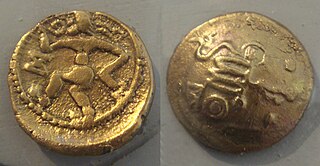Related Research Articles
The Calucones were a Gallic or Rhaetian tribe dwelling around present-day Chur during the Roman period.

The Petrocorii were a Gallic tribe dwelling in the present-day Périgord region, between the Dordogne and Vézère rivers, during the Iron Age and the Roman period.
The Medulli were a Gallic tribe dwelling in the upper valley of Maurienne, around present-day Modane (Savoie), during the Iron Age and Roman period.
The Alauni were a Gallic tribe dwelling around the lake Chiemsee during the Roman period.
The Nantuates or Nantuatae were a Gallic tribe dwelling around present-day Massongex, in the modern Canton of Valais (Switzerland) and adjacent areas of France, during the Iron Age and the Roman period.

The Bituriges Vivisci were a Gallic tribe dwelling near modern-day Bordeaux during the Roman period. They had a homonym tribe, the Bituriges Cubi in the Berry region, which could indicate a common origin, although there is no direct of evidence of this.

The Namnetes were a Gallic tribe dwelling near the modern city of Nantes during the Iron Age and the Roman period.

The Cocosates or Cocosates Sexsignani were an Aquitani tribe dwelling in present-day Landes during the Iron Age.

The Vindelici were a Gallic people dwelling around present-day Augsburg (Bavaria) during the Iron Age and the Roman period.
The Aneuniates were a small Gallic tribe dwelling near Lake Como, around present-day Samolaco, during the Roman period.
The Ausuciates were a small Gallic tribe dwelling around present-day Ossuccio, on the western shore of Lake Como, during the Roman period.
The Venisami or Venisamores were a Gallic tribe dwelling in the Alps during the Iron Age.
The Bergalei were a Gallic tribe dwelling in the Val Bregaglia during the Iron Age and the Roman period.
The Ambisontes were a Gallic tribe dwelling in the upper Salzach valley during the Roman period.
The Vennones or Vennonetes were a Gallic or Rhaetian tribe dwelling in the northern Alps, between Chur and Lake Constance, during the Iron Age and the Roman era.
The Rucinates or Rucantii were a Gallic tribe dwelling in near the confluence of the Isar and Danube rivers during the Roman period.
The Ambilici were a Gallic tribe dwelling in the valley of Gail river during the Roman period.
The Licates were a Gallic tribe dwelling in the upper valley of the Lech river during the Iron Age and the Roman period.
The Brixentes or Brixenetes were a Celtic or Rhaetian tribe living in the Alps during the Iron Age and the Roman era.
The Benacenses were a Gallic tribe dwelling west of Lake Garda during the Roman period.
References
- ↑ Strabo. Geōgraphiká, 4:6:8.
- ↑ Falileyev 2010, s.v. Brigantii.
- ↑ Ernst Meyer: Die geschichtlichen Nachrichten über die Räter und ihre Wohnsitze. In: Jahrbuch der Schweizerischen Gesellschaft für Ur- und Frühgeschichte. Vol. 55, 1970, p. 119—125
- ↑ Delamarre 2003, p. 87.
- ↑ Frei-Stolba 2004.
- 1 2 Dietz 2006.
- ↑ Talbert 2000, Map 19: Raetia.
Primary sources
- Strabo (1923). Geography. Loeb Classical Library. Translated by Jones, Horace L. Harvard University Press. ISBN 978-0674990562.
Bibliography
- Delamarre, Xavier (2003). Dictionnaire de la langue gauloise: Une approche linguistique du vieux-celtique continental. Errance. ISBN 9782877723695.
- Dietz, Karlheinz (2006). "Brigantium". Brill's New Pauly. doi:10.1163/1574-9347_bnp_e220090.
- Falileyev, Alexander (2010). Dictionary of Continental Celtic Place-names: A Celtic Companion to the Barrington Atlas of the Greek and Roman World. CMCS. ISBN 978-0955718236.
- Frei-Stolba, Regula (2004). "Brigantii". Historisches Lexikon der Schweiz .
- Talbert, Richard J. A. (2000). Barrington Atlas of the Greek and Roman World. Princeton University Press. ISBN 978-0691031699.
